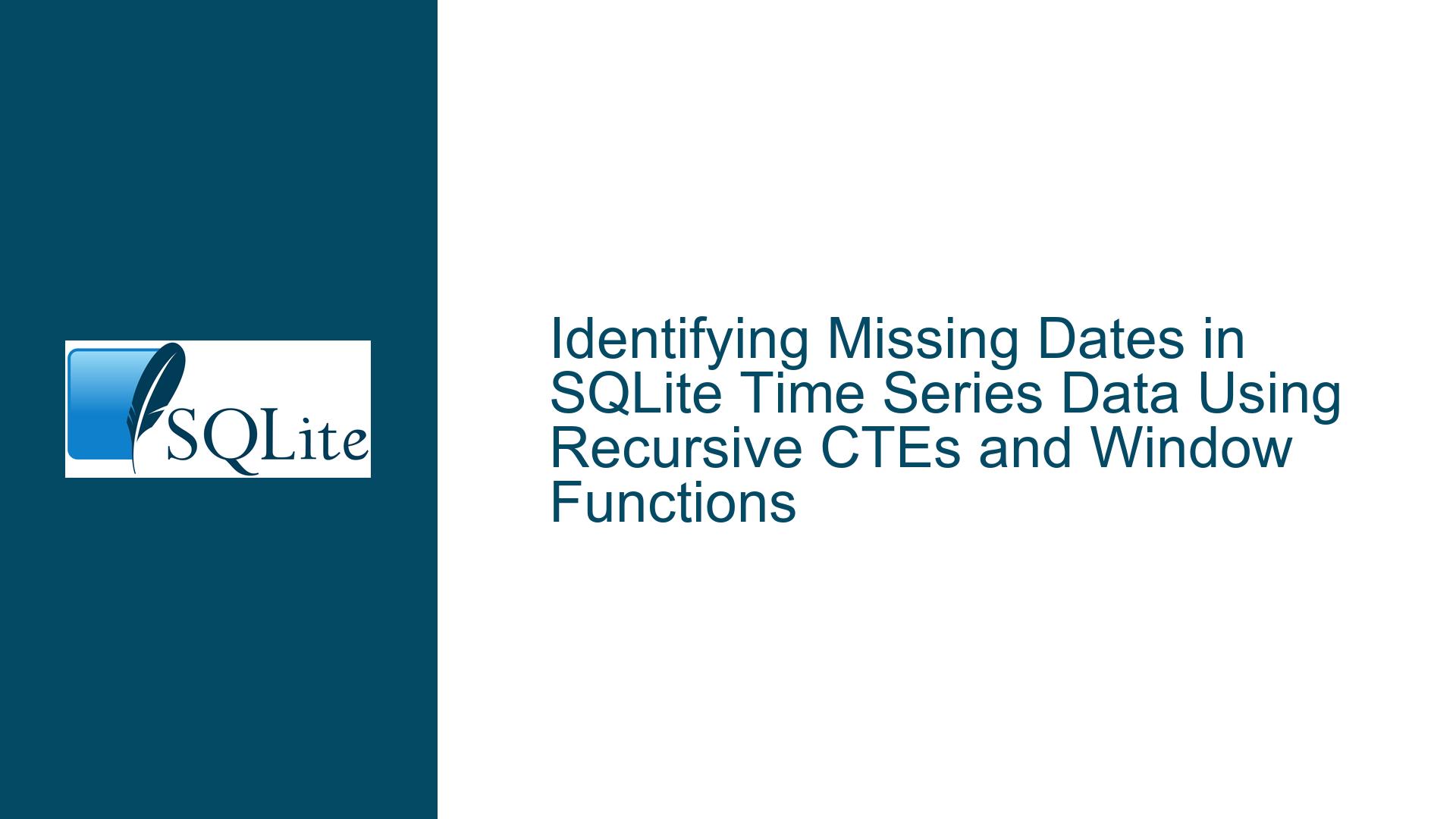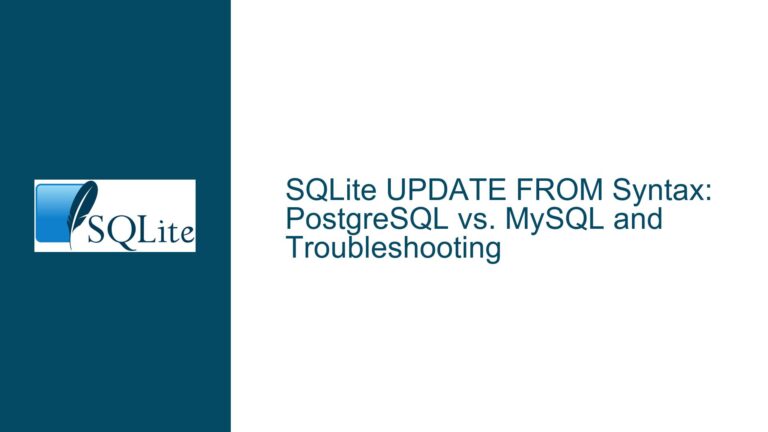Identifying Missing Dates in SQLite Time Series Data Using Recursive CTEs and Window Functions
Issue Overview: Detecting Gaps in Date Coverage Within SQLite Time Series Data
In time series data management, ensuring continuous date coverage is critical for accurate reporting and analysis. A common challenge arises when historical data collection processes experience intermittent failures, leading to missing dates in the dataset. This issue is particularly prevalent in systems that batch-insert or update date ranges, as gaps may go unnoticed until downstream processes (such as reporting or analytics) reveal inconsistencies.
In SQLite, where dates are often stored as ISO8601 strings (YYYY-MM-DD), identifying missing dates requires a methodical approach to generate the expected date sequence and compare it against existing records. The dataset described contains multiple entries per date over a nine-year span, with gaps introduced by sporadic data collection failures. The primary technical hurdle lies in efficiently generating the complete set of dates between the earliest (min(d_col)) and latest (max(d_col)) recorded dates, then isolating those absent from the dataset.
Key technical constraints include:
- Date Generation Mechanics: SQLite lacks built-in sequence generators for dates, requiring programmatic date range creation.
- Performance Considerations: A nine-year date range contains ~3,287 dates. Recursive CTEs must optimize termination conditions to prevent infinite loops.
- Data Validation: Dates stored as strings demand strict format adherence (ISO8601) for reliable comparison and date arithmetic.
- Duplicate Handling: Multiple entries per date necessitate DISTINCT or GROUP BY operations before gap analysis.
Possible Causes: Why Date Gaps Occur and Why Standard Queries Fail
1. Intermittent Data Collection Failures
Batch update processes that write date ranges may fail silently for specific subranges due to:
- Network timeouts during multi-day writes
- Resource constraints causing partial transaction rollbacks
- Logic errors in date range iteration (off-by-one errors, incorrect boundary handling)
2. Insufficient Data Validation
Absence of constraints like:
CHECK (d_col IS strftime('%Y-%m-%d', d_col))
allows invalid date strings that evade gap detection logic. Non-ISO formats (e.g., ‘2022/12/25’) would create false gaps.
3. Inefficient Gap Detection Methods
Naïve approaches like:
SELECT d_col FROM table GROUP BY d_col ORDER BY d_col;
only show existing dates, requiring manual inspection for gaps. Window functions and recursive CTEs are required for automated detection.
4. Time Zone Handling Issues
If dates are stored with timezone offsets (e.g., ‘2022-12-03+01:00’), string comparisons will fail to match dates without offset information. This creates phantom gaps despite data existence.
5. Indexing Deficiencies
Without a covering index on d_col:
CREATE INDEX idx_d_col ON table(d_col);
full table scans during date existence checks degrade performance on large datasets.
Troubleshooting Steps, Solutions & Fixes: Comprehensive Techniques for Date Gap Detection
Method 1: Recursive CTE Date Generation with EXCEPT Operation
Step 1: Establish Date Boundaries
First, calculate the temporal scope using correlated subqueries:
WITH date_limits AS (
SELECT
(SELECT MIN(d_col) FROM activity) AS start_date,
(SELECT MAX(d_col) FROM activity) AS end_date
)
SELECT start_date, end_date FROM date_limits;
Step 2: Generate Full Date Sequence
Use a recursive CTE to create the complete date series:
WITH RECURSIVE date_sequence(d) AS (
SELECT (SELECT MIN(d_col) FROM activity)
UNION ALL
SELECT DATE(d, '+1 day')
FROM date_sequence
WHERE d < (SELECT MAX(d_col) FROM activity)
)
SELECT d FROM date_sequence;
Optimization Notes:
- The WHERE clause prevents infinite recursion by stopping at end_date
- DATE() function ensures valid ISO8601 output
- Materialize the CTE with INDEXED tables for datasets >10 years
Step 3: Identify Missing Dates via Set Difference
Combine generated dates with existing data using EXCEPT:
WITH RECURSIVE date_sequence(d) AS (...)
SELECT d AS missing_date
FROM date_sequence
EXCEPT
SELECT d_col FROM activity;
Full Implementation with Error Handling:
WITH RECURSIVE
date_limits AS (
SELECT
MIN(d_col) AS start_date,
MAX(d_col) AS end_date
FROM activity
),
date_sequence(d) AS (
SELECT start_date FROM date_limits
UNION ALL
SELECT DATE(d, '+1 day')
FROM date_sequence, date_limits
WHERE d < end_date
)
SELECT
d AS missing_date,
(SELECT COUNT(*) FROM activity WHERE d_col = d) AS entries_missing
FROM date_sequence
WHERE d NOT IN (SELECT d_col FROM activity)
ORDER BY d;
Method 2: Window Function Approach Using LAG()
Step 1: Create Ordered Date Sequence
First, isolate unique dates and sort them:
CREATE TEMP VIEW unique_dates AS
SELECT DISTINCT d_col
FROM activity
ORDER BY d_col;
Step 2: Calculate Inter-Date Gaps with LAG()
Use the LAG window function to compare consecutive dates:
SELECT
d_col AS current_date,
LAG(d_col) OVER (ORDER BY d_col) AS previous_date,
JULIANDAY(d_col) - JULIANDAY(LAG(d_col) OVER (ORDER BY d_col)) AS day_gap
FROM unique_dates;
Step 3: Filter and Expand Gaps
Identify gaps >1 day and generate missing dates:
WITH gap_cte AS (
SELECT
d_col AS current_date,
LAG(d_col) OVER (ORDER BY d_col) AS previous_date,
JULIANDAY(d_col) - JULIANDAY(LAG(d_col) OVER (ORDER BY d_col)) AS day_gap
FROM unique_dates
)
SELECT
previous_date AS gap_start,
current_date AS gap_end,
day_gap - 1 AS missing_days,
DATE(previous_date, '+' || (gs.offset + 1) || ' day') AS missing_date
FROM gap_cte
CROSS JOIN generate_series(0, day_gap - 2) AS gs(offset)
WHERE day_gap > 1;
Note: generate_series is a virtual table generator (available via extensions) or emulated with recursive CTE.
Window Function Method Limitations:
- Cannot detect gaps before first date or after last date
- Requires contiguous existing dates to find "internal" gaps
- Less intuitive for generating complete missing date lists
Method 3: Hybrid Approach with Calendar Table
Step 1: Create Persistent Calendar Table
For frequent gap analyses, materialize a calendar table:
CREATE TABLE calendar (
date TEXT PRIMARY KEY CHECK (date IS strftime('%Y-%m-%d', date))
);
WITH RECURSIVE dates(d) AS (
SELECT '2000-01-01'
UNION ALL
SELECT DATE(d, '+1 day') FROM dates WHERE d < '2050-12-31'
)
INSERT INTO calendar SELECT d FROM dates;
Step 2: Join Calendar to Activity Data
SELECT c.date AS missing_date
FROM calendar c
LEFT JOIN activity a ON c.date = a.d_col
WHERE c.date BETWEEN (SELECT MIN(d_col) FROM activity)
AND (SELECT MAX(d_col) FROM activity)
AND a.d_col IS NULL;
Performance Considerations:
- Index calendar.date for O(1) lookups
- Partition calendar table by year for large ranges
- Use covering indexes on activity.d_col
Advanced Techniques: Temporal Gaps with Data Completeness
For datasets requiring both date existence and minimum row counts:
WITH date_stats AS (
SELECT
d_col,
COUNT(*) AS entry_count
FROM activity
GROUP BY d_col
HAVING entry_count < 5 -- Example threshold
)
SELECT
ds.d_col AS deficient_date,
ds.entry_count,
CASE WHEN c.date IS NULL THEN 1 ELSE 0 END AS completely_missing
FROM date_stats ds
FULL OUTER JOIN (
SELECT d FROM date_sequence -- From Method 1
) c ON c.d = ds.d_col
WHERE ds.d_col IS NULL OR c.d IS NULL;
Debugging Common Pitfalls
1. Infinite Recursion in CTE
Symptoms: Query never completes
Fix: Ensure termination condition uses static bounds:
WITH RECURSIVE seq(d) AS (
SELECT '2022-01-01'
UNION ALL
SELECT DATE(d, '+1 day')
FROM seq
WHERE d < (SELECT MAX(d_col) FROM activity) -- NOT from joined table
)
2. Timezone-Related False Gaps
Symptoms: Dates exist but appear missing due to TZ offsets
Resolution: Normalize all dates to UTC:
UPDATE activity
SET d_col = strftime('%Y-%m-%d', d_col || 'Z');
3. Performance Bottlenecks
For large datasets (>1M rows):
- Create temporary index on d_col during analysis:
CREATE TEMP INDEX IF NOT EXISTS tmp_d_col ON activity(d_col);
- Batch process date ranges:
WITH years AS (
SELECT
MIN(SUBSTR(d_col, 1, 4)) AS start_year,
MAX(SUBSTR(d_col, 1, 4)) AS end_year
FROM activity
)
SELECT year FROM (
WITH RECURSIVE years(year) AS (
SELECT start_year FROM years
UNION ALL
SELECT year + 1 FROM years WHERE year < end_year
)
SELECT year FROM years
);
Process each year separately to reduce memory pressure.
4. Handling Invalid Dates
Add validation step before gap analysis:
SELECT d_col
FROM activity
WHERE d_col NOT REGEXP '^\d{4}-\d{2}-\d{2}$'
OR strftime('%Y-%m-%d', d_col) IS NULL;
Comparative Analysis of Methods
| Method | Pros | Cons | Use Case |
|---|---|---|---|
| Recursive CTE | No schema changes; ad-hoc execution | Recursion depth limits; slower | One-time analysis |
| Window Functions | Identifies gap sizes; no date gen | Misses edge gaps; complex syntax | Internal gap analysis |
| Calendar Table | Fast for repeated use; simple joins | Requires storage; pre-generation | Frequent gap checks |
| Hybrid (CTE+Window) | Combines completeness and efficiency | Most complex implementation | Mission-critical systems |
Final Recommendations
- For Ad-Hoc Analysis: Use Method 1 (Recursive CTE) with EXCEPT
- For Production Monitoring: Implement Method 3 (Calendar Table) with materialized views
- For Data Quality Dashboards: Combine Method 2 (Window Functions) with entry_count thresholds
- For Large Datasets (>10M rows): Batch process using year/month partitions from Method 1
All solutions should be wrapped in transactions when modifying data:
BEGIN;
-- Gap detection and correction logic
COMMIT;
By implementing these techniques, you can systematically identify and address date gaps in SQLite datasets, ensuring data integrity for downstream applications. The choice between methods depends on your specific performance requirements, dataset size, and analysis frequency.






